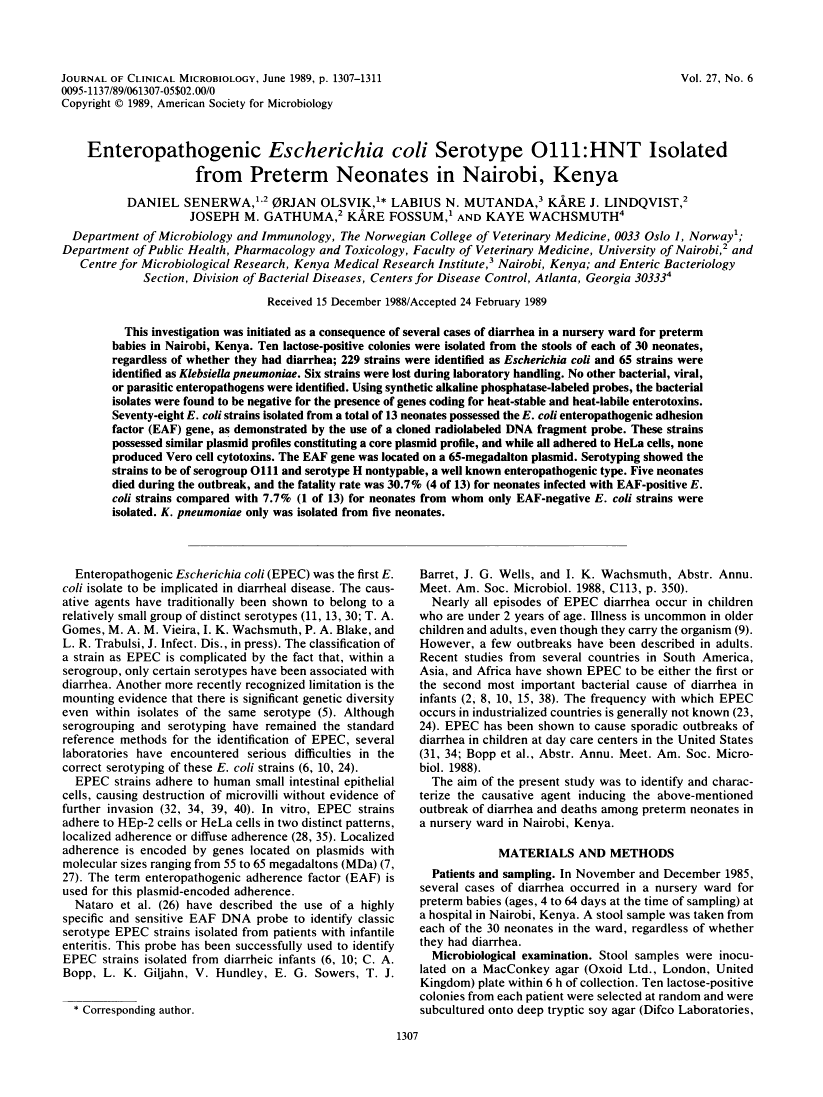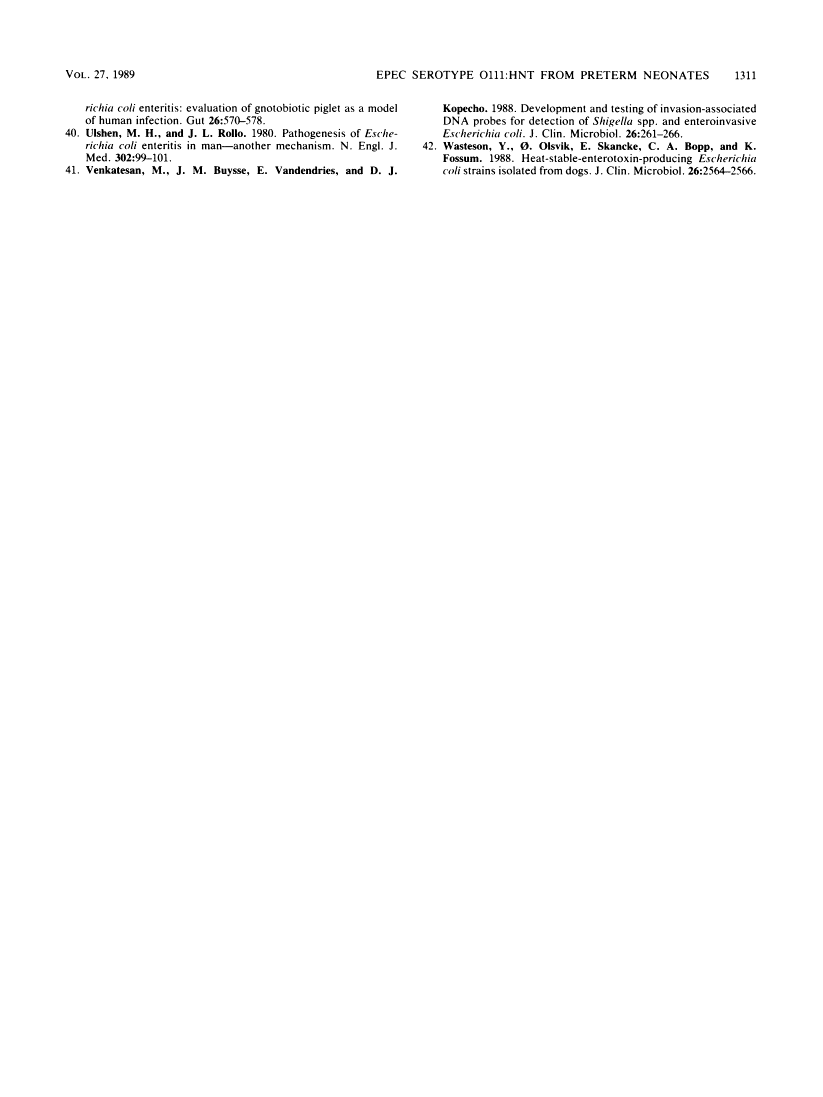Abstract
Free full text

Enteropathogenic Escherichia coli serotype O111:HNT isolated from preterm neonates in Nairobi, Kenya.
Abstract
This investigation was initiated as a consequence of several cases of diarrhea in a nursery ward for preterm babies in Nairobi, Kenya. Ten lactose-positive colonies were isolated from the stools of each of 30 neonates, regardless of whether they had diarrhea; 229 strains were identified as Escherichia coli and 65 strains were identified as Klebsiella pneumoniae. Six strains were lost during laboratory handling. No other bacterial, viral, or parasitic enteropathogens were identified. Using synthetic alkaline phosphatase-labeled probes, the bacterial isolates were found to be negative for the presence of genes coding for heat-stable and heat-labile enterotoxins. Seventy-eight E. coli strains isolated from a total of 13 neonates possessed the E. coli enteropathogenic adhesion factor (EAF) gene, as demonstrated by the use of a cloned radiolabeled DNA fragment probe. These strains possessed similar plasmid profiles constituting a core plasmid profile, and while all adhered to HeLa cells, none produced Vero cell cytotoxins. The EAF gene was located on a 65-megadalton plasmid. Serotyping showed the strains to be of serogroup O111 and serotype H nontypable, a well known enteropathogenic type. Five neonates died during the outbreak, and the fatality rate was 30.7% (4 of 13) for neonates infected with EAF-positive E. coli strains compared with 7.7% (1 of 13) for neonates from whom only EAF-negative E. coli strains were isolated. K. pneumoniae only was isolated from five neonates.
Full text
Full text is available as a scanned copy of the original print version. Get a printable copy (PDF file) of the complete article (969K), or click on a page image below to browse page by page. Links to PubMed are also available for Selected References.
Images in this article
Click on the image to see a larger version.
Selected References
These references are in PubMed. This may not be the complete list of references from this article.
- Antai SP, Anozie SO. Incidence of infantile diarrhoea due to enteropathogenic Escherichia coli in Port Harcourt metropolis. J Appl Bacteriol. 1987 Mar;62(3):227–229. [Abstract] [Google Scholar]
- Baldini MM, Kaper JB, Levine MM, Candy DC, Moon HW. Plasmid-mediated adhesion in enteropathogenic Escherichia coli. J Pediatr Gastroenterol Nutr. 1983;2(3):534–538. [Abstract] [Google Scholar]
- Caugant DA, Levin BR, Orskov I, Orskov F, Svanborg Eden C, Selander RK. Genetic diversity in relation to serotype in Escherichia coli. Infect Immun. 1985 Aug;49(2):407–413. [Europe PMC free article] [Abstract] [Google Scholar]
- Chatkaeomorakot A, Echeverria P, Taylor DN, Bettelheim KA, Blacklow NR, Sethabutr O, Seriwatana J, Kaper J. HeLa cell-adherent Escherichia coli in children with diarrhea in Thailand. J Infect Dis. 1987 Oct;156(4):669–672. [Abstract] [Google Scholar]
- Cravioto A, Reyes RE, Ortega R, Fernández G, Hernández R, López D. Prospective study of diarrhoeal disease in a cohort of rural Mexican children: incidence and isolated pathogens during the first two years of life. Epidemiol Infect. 1988 Aug;101(1):123–134. [Europe PMC free article] [Abstract] [Google Scholar]
- DuPont HL, Formal SB, Hornick RB, Snyder MJ, Libonati JP, Sheahan DG, LaBrec EH, Kalas JP. Pathogenesis of Escherichia coli diarrhea. N Engl J Med. 1971 Jul 1;285(1):1–9. [Abstract] [Google Scholar]
- Echeverria P, Taylor DN, Bettelheim KA, Chatkaeomorakot A, Changchawalit S, Thongcharoen A, Leksomboon U. HeLa cell-adherent enteropathogenic Escherichia coli in children under 1 year of age in Thailand. J Clin Microbiol. 1987 Aug;25(8):1472–1475. [Europe PMC free article] [Abstract] [Google Scholar]
- Edelman R, Levine MM. From the National Institute of Allergy and Infectious Diseases. Summary of a workshop on enteropathogenic Escherichia coli. J Infect Dis. 1983 Jun;147(6):1108–1118. [Abstract] [Google Scholar]
- Feinberg AP, Vogelstein B. A technique for radiolabeling DNA restriction endonuclease fragments to high specific activity. Anal Biochem. 1983 Jul 1;132(1):6–13. [Abstract] [Google Scholar]
- Freiman I, Hartman E, Kassel H, Robins-Browne RM, Schoub BD, Koornhof HJ, Lecatsas G, Prozesky OW. A microbiological study of gastro-enteritis in Black infants. S Afr Med J. 1977 Aug 6;52(7):261–265. [Abstract] [Google Scholar]
- Grunstein M, Hogness DS. Colony hybridization: a method for the isolation of cloned DNAs that contain a specific gene. Proc Natl Acad Sci U S A. 1975 Oct;72(10):3961–3965. [Europe PMC free article] [Abstract] [Google Scholar]
- Hill WE, Payne WL, Aulisio CC. Detection and enumeration of virulent Yersinia enterocolitica in food by DNA colony hybridization. Appl Environ Microbiol. 1983 Sep;46(3):636–641. [Europe PMC free article] [Abstract] [Google Scholar]
- Kado CI, Liu ST. Rapid procedure for detection and isolation of large and small plasmids. J Bacteriol. 1981 Mar;145(3):1365–1373. [Europe PMC free article] [Abstract] [Google Scholar]
- Karch H, Heesemann J, Laufs R. Phage-associated cytotoxin production by and enteroadhesiveness of enteropathogenic Escherichia coli isolated from infants with diarrhea in West Germany. J Infect Dis. 1987 Apr;155(4):707–715. [Abstract] [Google Scholar]
- KAUFFMANN F, DUPONT A. Escherichia strains from infantile epidemic gastro enteritis. Acta Pathol Microbiol Scand. 1950;27(4):552–564. [Abstract] [Google Scholar]
- Konforti N, Lev B, Hanner N. Sensitivity of strains of enteropathogenic Escherichia coli to tobramycin and other antibiotics. Med Microbiol Immunol. 1977 Dec 27;163(4):269–276. [Abstract] [Google Scholar]
- Konowalchuk J, Speirs JI, Stavric S. Vero response to a cytotoxin of Escherichia coli. Infect Immun. 1977 Dec;18(3):775–779. [Europe PMC free article] [Abstract] [Google Scholar]
- Levine MM. Escherichia coli that cause diarrhea: enterotoxigenic, enteropathogenic, enteroinvasive, enterohemorrhagic, and enteroadherent. J Infect Dis. 1987 Mar;155(3):377–389. [Abstract] [Google Scholar]
- Levine MM, Edelman R. Enteropathogenic Escherichia coli of classic serotypes associated with infant diarrhea: epidemiology and pathogenesis. Epidemiol Rev. 1984;6:31–51. [Abstract] [Google Scholar]
- Levine MM, Xu JG, Kaper JB, Lior H, Prado V, Tall B, Nataro J, Karch H, Wachsmuth K. A DNA probe to identify enterohemorrhagic Escherichia coli of O157:H7 and other serotypes that cause hemorrhagic colitis and hemolytic uremic syndrome. J Infect Dis. 1987 Jul;156(1):175–182. [Abstract] [Google Scholar]
- Nataro JP, Baldini MM, Kaper JB, Black RE, Bravo N, Levine MM. Detection of an adherence factor of enteropathogenic Escherichia coli with a DNA probe. J Infect Dis. 1985 Sep;152(3):560–565. [Abstract] [Google Scholar]
- Nataro JP, Maher KO, Mackie P, Kaper JB. Characterization of plasmids encoding the adherence factor of enteropathogenic Escherichia coli. Infect Immun. 1987 Oct;55(10):2370–2377. [Europe PMC free article] [Abstract] [Google Scholar]
- Nataro JP, Scaletsky IC, Kaper JB, Levine MM, Trabulsi LR. Plasmid-mediated factors conferring diffuse and localized adherence of enteropathogenic Escherichia coli. Infect Immun. 1985 May;48(2):378–383. [Europe PMC free article] [Abstract] [Google Scholar]
- Nicoletti M, Superti F, Conti C, Calconi A, Zagaglia C. Virulence factors of lactose-negative Escherichia coli strains isolated from children with diarrhea in Somalia. J Clin Microbiol. 1988 Mar;26(3):524–529. [Europe PMC free article] [Abstract] [Google Scholar]
- Paulozzi LJ, Johnson KE, Kamahele LM, Clausen CR, Riley LW, Helgerson SD. Diarrhea associated with adherent enteropathogenic Escherichia coli in an infant and toddler center, Seattle, Washington. Pediatrics. 1986 Mar;77(3):296–300. [Abstract] [Google Scholar]
- Polotsky YE, Dragunskaya EM, Seliverstova VG, Avdeeva TA, Chakhutinskaya MG, Kétyi I, Vertényl A, Ralovich B, Emödy L, Málovics I, et al. Pathogenic effect of enterotoxigenic Escherichia coli and Escherichia coli causing infantile diarrhoea. Acta Microbiol Acad Sci Hung. 1977;24(3):221–236. [Abstract] [Google Scholar]
- Riley LW, Junio LN, Libaek LB, Schoolnik GK. Plasmid-encoded expression of lipopolysaccharide O-antigenic polysaccharide in enteropathogenic Escherichia coli. Infect Immun. 1987 Sep;55(9):2052–2056. [Europe PMC free article] [Abstract] [Google Scholar]
- Rothbaum R, McAdams AJ, Giannella R, Partin JC. A clinicopathologic study of enterocyte-adherent Escherichia coli: a cause of protracted diarrhea in infants. Gastroenterology. 1982 Aug;83(2):441–454. [Abstract] [Google Scholar]
- Scaletsky IC, Silva ML, Trabulsi LR. Distinctive patterns of adherence of enteropathogenic Escherichia coli to HeLa cells. Infect Immun. 1984 Aug;45(2):534–536. [Europe PMC free article] [Abstract] [Google Scholar]
- Seriwatana J, Echeverria P, Taylor DN, Sakuldaipeara T, Changchawalit S, Chivoratanond O. Identification of enterotoxigenic Escherichia coli with synthetic alkaline phosphatase-conjugated oligonucleotide DNA probes. J Clin Microbiol. 1987 Aug;25(8):1438–1441. [Europe PMC free article] [Abstract] [Google Scholar]
- Southern EM. Detection of specific sequences among DNA fragments separated by gel electrophoresis. J Mol Biol. 1975 Nov 5;98(3):503–517. [Abstract] [Google Scholar]
- Toledo MR, Alvariza M do C, Murahovschi J, Ramos SR, Trabulsi LR. Enteropathogenic Escherichia coli serotypes and endemic diarrhea in infants. Infect Immun. 1983 Feb;39(2):586–589. [Europe PMC free article] [Abstract] [Google Scholar]
- Tzipori S, Robins-Browne RM, Gonis G, Hayes J, Withers M, McCartney E. Enteropathogenic Escherichia coli enteritis: evaluation of the gnotobiotic piglet as a model of human infection. Gut. 1985 Jun;26(6):570–578. [Europe PMC free article] [Abstract] [Google Scholar]
- Ulshen MH, Rollo JL. Pathogenesis of escherichia coli gastroenteritis in man--another mechanism. N Engl J Med. 1980 Jan 10;302(2):99–101. [Abstract] [Google Scholar]
- Venkatesan M, Buysse JM, Vandendries E, Kopecko DJ. Development and testing of invasion-associated DNA probes for detection of Shigella spp. and enteroinvasive Escherichia coli. J Clin Microbiol. 1988 Feb;26(2):261–266. [Europe PMC free article] [Abstract] [Google Scholar]
- Wasteson Y, Olsvik O, Skancke E, Bopp CA, Fossum K. Heat-stable-enterotoxin-producing Escherichia coli strains isolated from dogs. J Clin Microbiol. 1988 Dec;26(12):2564–2566. [Europe PMC free article] [Abstract] [Google Scholar]
Associated Data
Articles from Journal of Clinical Microbiology are provided here courtesy of American Society for Microbiology (ASM)
Full text links
Read article at publisher's site: https://doi.org/10.1128/jcm.27.6.1307-1311.1989
Read article for free, from open access legal sources, via Unpaywall:
https://jcm.asm.org/content/jcm/27/6/1307.full.pdf
Free after 4 months at intl-jcm.asm.org
http://intl-jcm.asm.org/cgi/reprint/27/6/1307.pdf
Free to read at intl-jcm.asm.org
http://intl-jcm.asm.org/cgi/content/abstract/27/6/1307
Citations & impact
Impact metrics
Citations of article over time
Smart citations by scite.ai
Explore citation contexts and check if this article has been
supported or disputed.
https://scite.ai/reports/10.1128/jcm.27.6.1307-1311.1989
Article citations
Pathophysiology of Enteropathogenic Escherichia coli-induced Diarrhea.
Newborn (Clarksville), 2(1):102-113, 01 Jan 2023
Cited by: 3 articles | PMID: 37388762 | PMCID: PMC10308259
Preparative scale purification of fucosyl-N-acetylglucosamine disaccharides and their evaluation as potential prebiotics and antiadhesins.
Appl Microbiol Biotechnol, 99(17):7165-7176, 16 May 2015
Cited by: 17 articles | PMID: 25977209
Characterization of a novel EAST-negative enteropathogenic E. coli strain implicated in a food-borne outbreak of diarrhoea in adults.
APMIS, 121(6):494-502, 08 Nov 2012
Cited by: 2 articles | PMID: 23134539
How can the microbiologist help in diagnosing neonatal sepsis?
Int J Pediatr, 2012:120139, 26 Jan 2012
Cited by: 35 articles | PMID: 22319539 | PMCID: PMC3272815
Review Free full text in Europe PMC
CsrA and TnaB coregulate tryptophanase activity to promote exotoxin-induced killing of Caenorhabditis elegans by enteropathogenic Escherichia coli.
J Bacteriol, 193(17):4516-4522, 24 Jun 2011
Cited by: 18 articles | PMID: 21705596 | PMCID: PMC3165518
Go to all (30) article citations
Similar Articles
To arrive at the top five similar articles we use a word-weighted algorithm to compare words from the Title and Abstract of each citation.
Colonization of neonates in a nursery ward with enteropathogenic Escherichia coli and correlation to the clinical histories of the children.
J Clin Microbiol, 27(11):2539-2543, 01 Nov 1989
Cited by: 3 articles | PMID: 2681255 | PMCID: PMC267073
Enteropathogenicity markers in Escherichia coli isolated from infants with acute diarrhoea and healthy controls in Rio de Janeiro, Brazil.
J Med Microbiol, 47(9):781-790, 01 Sep 1998
Cited by: 41 articles | PMID: 9736160
Survey of cytotoxin production among Escherichia coli strains characterized as enteropathogenic (EPEC) by serotyping and presence of EPEC adherence factor (EAF) sequences.
Can J Microbiol, 40(5):341-344, 01 May 1994
Cited by: 16 articles | PMID: 7520828
Enteropathogenic Escherichia coli of classic serotypes associated with infant diarrhea: epidemiology and pathogenesis.
Epidemiol Rev, 6:31-51, 01 Jan 1984
Cited by: 167 articles | PMID: 6386503
Review










